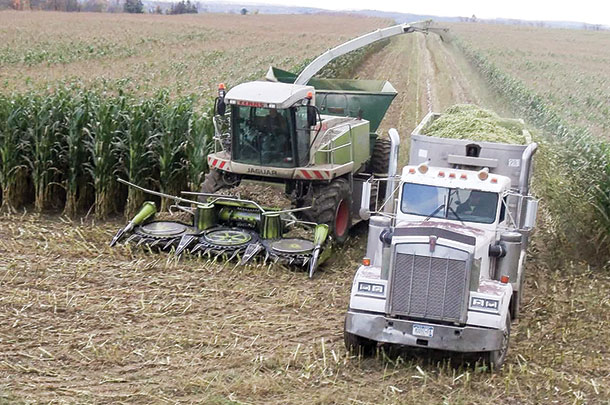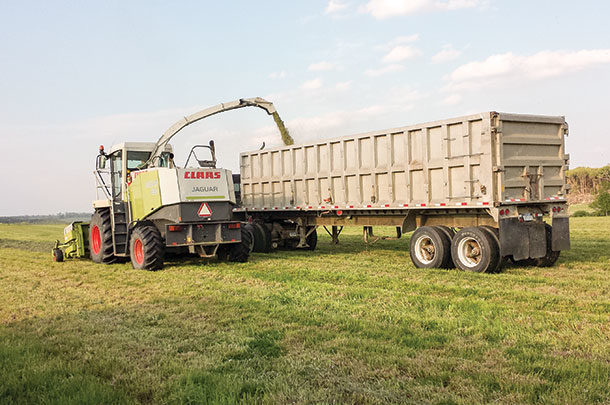For Jason Gerber of Addison, New York, a comment a fellow farmer made to him nearly five years ago didn’t just “stick” with him, it completely altered the way he viewed and managed his family’s dairy business.
It went a little something like this: “Everybody has the opportunity to put up top-quality forage; it’s just a matter of whether you take advantage of it at its prime.”
Prompting a change
Located in the hills of south-central New York, near the Pennsylvania border, Dwi-Bet Farms – operated by Ken and his two sons, Jeff and Jason Gerber – milks 500 cows and crops approximately 1,200 acres of corn silage, corn grain, grass silage, soybeans, small grains and dry grass hay.
The farm originally began in Rochester, New York, in the early 1950s by Jason’s grandparents, Dwight and Betty Gerber. Looking to make some changes, all three generations of the Gerber family decided to relocate their farm to Addison in 2005 for a fresh start.
At the time, Jason and Jeff were graduating from college with degrees in animal science and ag mechanics, respectively. Both wanting to return to the farm, the decision to relocate gave them the perfect opportunity to not only come back but to implement some of their college expertise.
“A lot of other people in mine or my brother’s position would’ve had a difficult time walking out of college saying, ‘You know what, Dad? This is what we learned in college, and I think we need to change our cropping strategy,’” Jason says. “That doesn’t really go over well. But because we are on a blank chalkboard – my dad, my brother, my grandfather and myself – no individual can say, ‘This is how we’ve always done it, so this is how we have to do it.’”
With that “blank chalkboard” mindset and understanding that no one had managed a farm of that size, in that location and to that capacity, the Gerbers were able to make some pretty big adjustments to their farm that has led to improved profitability over time.
Quality vs. quantity
Within the last three or four years, the Gerbers made the decision to take heifers off the farm. This decision really opened up opportunities in terms of focusing on “quality” versus “quantity” of feed without the urgency to harvest enough feed for more animals.
In the past, Jason points out that they had very good yields and big inventories, but the quality wasn’t quite where they wanted it to be. They have found it is much easier to focus on quality from the get-go rather than trying to fix the problem with additives once it’s piled and fed to the cows.
“There is always going to be a point of time where grass, alfalfa or corn silage is at a prime quality level – specifically with grass haylage,” Jason says. “It’s just a matter of – do you take the opportunity that day or that week to go get it? Or are you concentrating on planting corn when you really should be chopping haylage?"
"We could wait another two weeks and get a lot more tonnage, but if we take the cutting now we might get an extra cutting over time by taking it early and by taking it at the top quality.”

Jason further explains that they may not get 20 to 25 tons or the top end that their ground can yield, but the quality will pay back faster than the yield. As an example, he says they might only get 17 tons, but 70 to 75 percent of that tonnage is going to get used for milk.
On the other hand, if they have 20 tons of silage, only 50 percent of that is used for milk, and the rest goes back into the manure system, he says.
The Gerbers will be the first to admit that a lot of what makes them “tick” is their understanding on how everything in the field converts to the diet. It’s all about understanding how it affects the animal – the milk production and the digestion – that makes them profitable, Jason says.
“If you start the year off with your haylage and you make sure when you’re starting that corn silage it’s not too wet, not too dry, not too mature, not too immature – if you hit those things right on the head, that’s going to do more for your profitability than anything else,” Jason explains.
“It’s one thing to have a whole bunch of tonnage sitting out here on your farm or in your silo – when you take that sample you say, ‘Oh, my corn silage is low in starch and 28 percent dry matter. I can’t feed much of this because it’s got so much butyric acid in it and there’s no starch because I chopped it two weeks early.’"
"Or it’s 50 percent dry matter and hard kernels and the starch isn’t all that available, but it’s there and half of it is going out in the manure. Both of those situations are going to be a lot less profitable than if I would have hit it right on the head.”
Profitable practices
As far as the preparation of their land goes, Jason says they incorporate manure in the fall, and then in the spring they incorporate and chisel plow manure into the soil. They believe applying manure and chisel plowing that in, and getting what little stock is left over down into the ground, helps break up the pest cycle and the compaction in the soil.
They don’t have a lot of excess fertilizers that they have to apply because they try to allocate manure during the right time – one right time being after the corn silage harvest. In doing so, they have been able to maintain good fertility in their soils and have kept nutrient levels at a productive, not excessive level.
In addition, the Gerbers believe having “larger equipment than what most folks think they should have,” helps them cover ground on their own. As Jason put it, their farm is “tied to size,” as it’s too small to have a full-time crop crew yet too large to do it alone.
When the Gerbers made the move to Addison, the farm had two pull-type choppers and they already owned one pull-type chopper. The farm also had four self-moving wagons and they already had three; together they made the decision to get rid of all of that and purchase two trucks and one self-propelled chopper.
It may not be as fast, but it allows them to get harvesting done with just a couple of people, Jason says.
One thing’s for sure about the Gerbers – they are a competitive family that enjoys the challenge of farming and improving everything they do.
As Jason says, “We try to compete every year against our prior year’s forage tests. How can we get more digestibility, higher yield, more milk per ton and ultimately more milk in the tank and out the door? It’s all about figuring out what the next weakest link is and working on that to reach the next level.”
Although the Gerbers won’t be the first to admit they are doing an exceptional job at producing high-quality forage for their dairy, it’s easy to see that their “begin with the end in mind” approach has improved profitability in their business.
It’s amazing what some small adjustments in management and alterations in thinking can do. ![]()
PHOTO 1: The Gerbers live by the saying, “Once you see the head, the quality is dead.” They are prepared to make adjustments in their management to make sure the haylage is harvested at its prime.
PHOTO 2: The Gerbers own an 850 Claas chopper outfitted with a shredlage processor to get optimal kernel processing and have been happy with the results over the last two seasons they have used the updated processor. Photos courtesy of Jason Gerber.

-
Cassidy Woolsey
- Editor
- Progressive Forage
- Email Cassidy Woolsey











